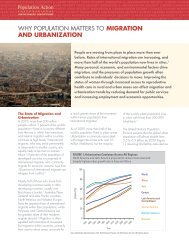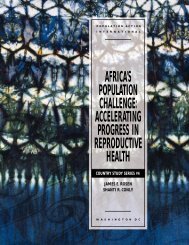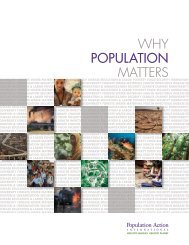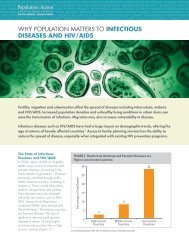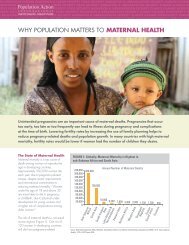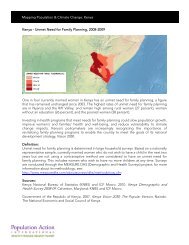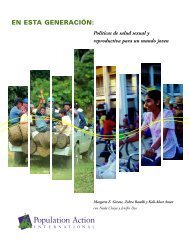Sustaining water, easing scarcity - Population Action International
Sustaining water, easing scarcity - Population Action International
Sustaining water, easing scarcity - Population Action International
Create successful ePaper yourself
Turn your PDF publications into a flip-book with our unique Google optimized e-Paper software.
Comparison of Current and Projected Fresh<strong>water</strong> Stress and Scarcity<br />
Current<br />
Fresh<strong>water</strong> Availability<br />
1995 population # of<br />
countries<br />
Scarcity 166 million 18<br />
Stress 270 million 11<br />
Total World<br />
<strong>Population</strong> 5.7 billion<br />
Using 1994 and 1996 UN <strong>Population</strong> Projections<br />
1994 UN Projections 1996 UN Projections<br />
population # of countries* population # of countries*<br />
2050 (LOW)<br />
Scarcity 1.1 billion 33 1.0 billion 31<br />
Stress 2.4 billion 18 970 million 17<br />
Total World <strong>Population</strong> 7.9 billion 7.7 billion<br />
2050 (MEDIUM)<br />
Scarcity 1.9 billion 43 1.7 billion 39<br />
Stress 2.5 billion 15 2.3 billion 15<br />
Total World <strong>Population</strong> 9.8 billion 9.4 billion<br />
2050 (HIGH)<br />
Scarcity 2.4 billion 44 2.2 billion 42<br />
Stress 5.3 billion 22 4.6 billion 18<br />
Total World <strong>Population</strong> 11.9 billion 11.2 billion<br />
*The table on the left lists the number of people currently living in countries considered <strong>water</strong> scarce or <strong>water</strong> stressed.<br />
The table above compares estimates of number of people projected to live in <strong>water</strong> scarce or <strong>water</strong> stressed countries<br />
in 2050 based on low, medium and high 1994 and 1996 UN population projections. Note that the total number of<br />
countries and people estimated to experience <strong>water</strong> stress and <strong>scarcity</strong> is lower under all three 1996 projections.<br />
related to their use of this shared natural resource. 34<br />
The whole world is watching the Nile and<br />
similar international <strong>water</strong>sheds. At a March 1997<br />
forum on international <strong>water</strong> issues in Marrakech,<br />
Morocco, UN Secretary General Kofi Annan<br />
stressed that the projected growth of world population<br />
over the next 30 years makes developing<br />
cooperative international agreements on shared<br />
<strong>water</strong> resources “one of the most urgent issues on<br />
the global agenda.” 35 And in May, the UN General<br />
Assembly approved a convention to establish<br />
guidelines for cooperation on sharing the benefits<br />
of international <strong>water</strong>courses. 36 The U.S. State<br />
Department and Environmental Protection Agency<br />
have opened field offices called environmental<br />
hubs to help developing nations negotiate transboundary<br />
solutions to regional environmental<br />
problems such as fresh<strong>water</strong> <strong>scarcity</strong>, deforestation<br />
and air pollution, and to raise the profile of environmental<br />
issues in global diplomacy. The Eastern<br />
Africa hub, which specializes in Nile Basin <strong>water</strong><br />
resource issues, recently opened in Addis Ababa. 37<br />
The growing interest in the region’s <strong>water</strong><br />
issues is encouraging, but the challenge of reconciling<br />
competing claims on the Nile will continue<br />
to be complicated by political and economic concerns.<br />
The scope for <strong>water</strong> conservation and international<br />
cooperation is large, but the competition is<br />
unlikely to find permanent resolution until the<br />
region’s population approaches stabilization.<br />
Why <strong>Population</strong> Matters<br />
As recent changes in projected population growth<br />
illustrate, population projections can change for the<br />
worse or for the better depending on the factors<br />
that influence them. The difference between the<br />
1994 and 1996 UN projections demonstrates the<br />
impact that even slight changes in population<br />
growth rates can have over time on the amount of<br />
renewable fresh <strong>water</strong> available to each person.<br />
Slower population growth rates do not, however,<br />
occur on their own. They result from the desires of<br />
hundreds of millions of women and men to have<br />
fewer children—and the efforts of governments and<br />
other institutions to help them achieve these goals<br />
throughout their reproductive years. Now more<br />
than ever, sound policies that will promote the<br />
transition to a stable population size remain critical.<br />
Pursued consistently, such efforts can delay the<br />
onset of <strong>water</strong> stress and <strong>scarcity</strong> in many countries,<br />
buying precious time for strategies that can<br />
make fresh<strong>water</strong> resources endure for generations<br />
to come.<br />
13



